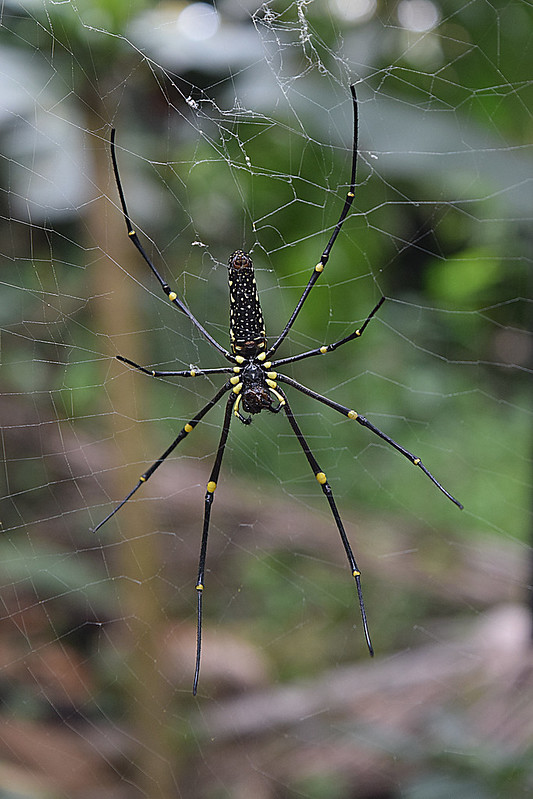
Philippine Eagle Foundation Davao
Philippine Eagle Foundation, Davao
While in Davao, Philippines recently, I visited the Philippine Eagle Foundation’s conservation Center.

It took an hour by Grab to get to the center, which is on the outskirts of Davao City. The Philippine Eagle, (Scientific Name: Pithecophaga jefferyi) also known as the monkey-eating eagle after its favorite food, has a Critically endangered Status. It is believed that there are less than 400 pairs remaining living in the wild. Eagles found injured are brought to the foundation with the goal of getting them well and returned to the wild. If they can not recover fully and are unable to hunt for themselves, they will stay at the conservation center. Birds at the center are also used in research and a breeding program. There are currently 7 Philippine Eagles in an exhibit for education, while the rest are isolated for conservation breeding and research purposes.

The center is also home to other birds of prey who can not return to the wild.
From their website: The Philippine Eagle Center (PEC) is an 8.4-hectare area located at the foothills of Mt. Apo in Malagos, Baguio District, Davao City, and situated within the Malagos Watershed. The Philippine Eagle Center primarily operates as a conservation breeding facility for the critically endangered Philippine Eagle (Pithecophaga jefferyi) and other birds of prey.
The Center is divided into different functional areas, such as:
- Conservation Breeding Area. This is where the breeding birds are found. This area is restricted to the public and only the conservation breeding personnel are allowed on its premises.
- Food Stock Area. This is where the food for the raptors and other animals are raised to ensure a disease-free stock such as rabbits, white mice, quails, and guinea pigs. These stocks are needed for the daily food requirements of every animal at the Center.
- Exhibit Area. This area is open to the general public, wherein exhibit animals are displayed. It is further divided into two parts:
-
- The close canopy (covered by trees) area is a natural forest adjacent to the Malagos Watershed. Here you will find large old trees and the first few cages that the Philippine Eagle Foundation ever built. Being a natural forest, this part of the Center is relatively rough compared to the rest.
- The plaza/exhibit part is an open canopy area with concrete pathways leading to every enclosure, kiosks, and benches available for the guests.
-
 The conservation center is a little underwhelming. Overall, it is very small but depending on the amount of time you watch the birds and other wildlife can take you anywhere from 30 minutes to 2 hours to see. Three hours for photographers. There are a number of cages that each house one bird, mostly Eagles, the rest other birds of prey. An audio-video presentation is also available.
The conservation center is a little underwhelming. Overall, it is very small but depending on the amount of time you watch the birds and other wildlife can take you anywhere from 30 minutes to 2 hours to see. Three hours for photographers. There are a number of cages that each house one bird, mostly Eagles, the rest other birds of prey. An audio-video presentation is also available.

There is an “island” of Long-tailed Macaque. I will admit it was amazing watching the social interactions these primates had between themselves.
The foundation’s website also has this to say:
We need to protect the Philippine Eagle for the following reasons:
- It is found nowhere else except in the Philippines, where it is the country’s national bird. Losing the species to extinction would also mean losing a nation’s precious biological heritage.
- It represents a rare product of evolutionary creation. Based on recent genetic studies, it has no close relatives left among the living species of eagles in the world. Losing them would mean an irreversible loss of a unique species.
- The Philippine Eagle is the top predator of the Philippine tropical rainforest. It plays an important role in keeping the ecosystem in balance and provides an umbrella of protection to all other life forms in its territory.
- The Philippine Eagle is embedded in the oral histories and other cultural artifacts of several indigenous groups in the country. This indicates that it performs a role in the human production of unique cultures.
- Economically, the presence of a healthy eagle population can also be a source of livelihood for the communities living near its area, such as eco-tourism. Additionally, a healthy forest helps control soil erosion, mitigate the effects of climate change, minimize flooding, and provide additional sources of food, medicine, clothing, and shelter for our people.
- This different spectrum of values unifies the diverse facets of our society. The role that the Philippine Eagle plays rightly deserves its title as the Philippine national bird- a symbol of unity, beauty, and hope. This underscores the need to protect it for future Filipinos and the rest of the world to benefit and enjoy.
The entrance to the center is only 150 pesos for adults, less for children. That is about USD 3.

We took a Grap (merged with uber last year) to the center from downtown to the center for about 700 pesos, $14. On our return trip, we took a trike to the transportation center nearby for less than a dollar and from the transportation center took a L300 (a commuter style van) back downtown for about $1 each.









